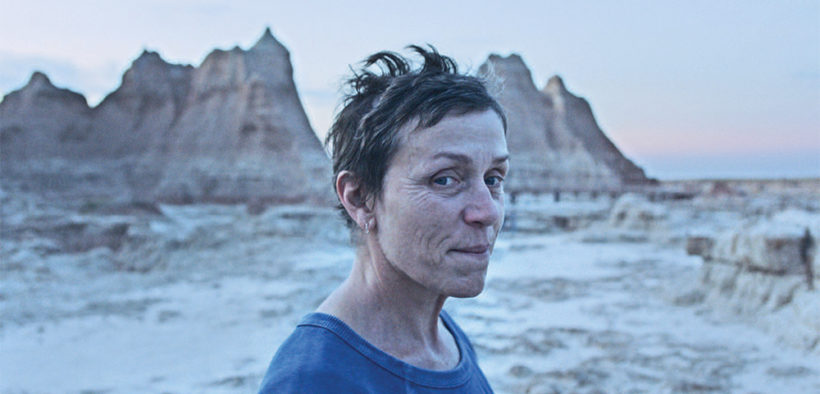
By Kevin Murphy
Fern (Frances McDormand) goes through a storage room on a cold winter day. She comes across a men’s denim jacket that, with tears in her eyes, she clutches to her chest before setting out on the road in her van. Not long after, she’s seen hustling through a busy work schedule at a bleak Amazon fulfilment warehouse.
These are the opening scenes to “Nomadland”. Directed by Chloé Zhao, the film is based on the 2017 non-fiction book of the same title written by Jessica Bruder. These early scenes epitomize an underlying theme of the film: corporate capitalism has shattered the American dream, and left many people searching for a home in the world that broke them.
Following the Great Recession of 2008, the gypsum plant where Fern and her husband worked in Empire, Nevada closed down. The plant was the livelihood of the small town’s economy and when it closed, Empire’s zip code was wiped from existence. After the death of her husband, Fern sells most of her belongings and buys a van to live in while traveling the country in search of employment and a new life.
Fern’s friend and co-worker Linda May invites her to visit a camping seminar in the Arizona desert organized by Bob Wells (both of whom are portrayed by their real life counterparts). The seminar offers a support group for those who have traded their consumerist pasts for a self-dependent, nomadic life on the road. Inspired by Wells, Fern continues her cross-country journey, taking part-time jobs and meeting people that have experienced the same heartbreak and loss of purpose in their lives. When she meets a fellow nomad named David (David Strathairn), he threatens to detour her life on the road.
The nomads Fern encounters along the way have different reasons for leaving their former lives behind. Whether it’s the suicidal depression of abandonment, the loss of loved ones, an impending terminal illness, or just the need to escape socially accepted traditional routines, the characters Fern meets along the way paint the picture of a forsaken class of American culture.
Zhao — who also wrote the screenplay — deploys long, wide shots displaying the beautiful American landscape from the Oregon coast to the Badlands of South Dakota with a Terrence Malick-esque patience and mastery. The clever way Zhao intertwines real people playing fictionalized versions of themselves with performances by veteran actors like McDormand and Strathairn lend to the film’s sense of authenticity and heartbreaking beauty that most Hollywood films lack.
The film cuts to the core of who we really are as people — a social yet lonely group desperate for human connection and purpose. Even the characters that are trapped in a life dictated by social status are portrayed with a sense of innocence and decency. There are no heroes or villains, just people doing the best that they can in a world with pre-set social norms. There is a sense of sadness and longing in all of the characters’ eyes that give the audience a glimpse of who they truly are behind the facade of their trained appearances.
In an American culture where material possessions and financial status determine your worth, “Nomadland” gives a glimpse of the exit path from America’s broken promises, while highlighting the fragility and wonder of life itself.
